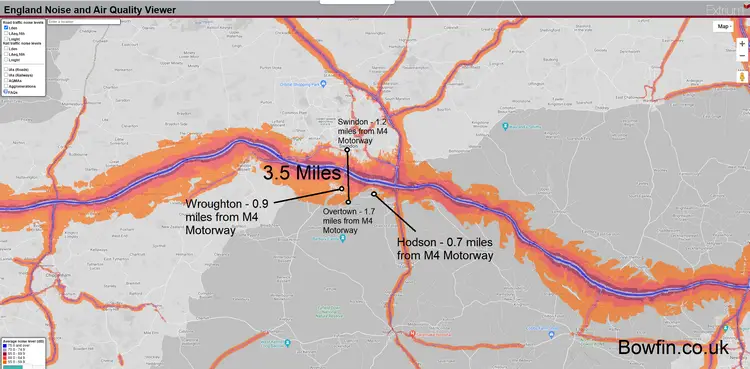
If you are thinking about buying a house near to a motorway, it’s the noise pollution that seems to bother most people, rather than the actual smoke pollution from the cars.
So you may be wondering how far away from a motorway you can hear the noise pollution, and what factors affect noise levels.
If you live within one to 1.5 miles of a motorway or a major road, you will still be able to hear a steady hum of traffic noise. The level of noise will be affected by the time of day, if it’s been raining, the topography of the land between you and the major road and the prevailing wind direction.
Having said this, you should read on further to find out what impacts noise levels and how for example, a village that’s about 0.7 miles from the M4 Motorway is outside the 55-59.99 decibel range due to topography.

How to test the level of noise you can hear at the property
To test noise levels at the property you should visit at different times of the day. Make sure to visit at the busiest times and during rush hour to get a feel for traffic noise.
But bear in mind you will get a different noise level experience when the traffic is free flowing vs stop and start (see below).
The noise level will also be different in varying weather conditions too (also see below).
But you’ll probably find the sound of free flowing traffic sounds a bit like the sea in the background, which is the noise of the tyres on the tarmac.
You should also take a look at this noise and air quality viewer for England, which provides information on the level of noise and air quality around major highways and motorways in England. But even if you don’t live in England, it’s a useful reference to understand decibel levels at different distances from a major highway.
In the above image, which has been taken from the above linked-to website, you’ll see a point on the M4 motorway has been marked between Swindon and Overtown, which is roughly 3.5 miles apart as the crow flies.
- Overtown is about 1.7 miles from the motorway itself. This means that the level of noise from the M4 motorway is just outside the average noise level of between 55 to 59.99 decibels (dB). If you’re just outside of this noise range, and in a 50dB noise level, the sound will be less than or similar to that of a refrigerator noise (see table below). But if you move slightly closer than Overtown is to within about 1.5 miles from the motorway, the noise level increases to the 55-59.99dB level.
- Swindon is approximately 1.2 miles from the M4 Motorway and outside the 55 to 59.99 decibel range too. But of course if you live in Swindon you will be affected by city traffic noise instead.
- If you move closer to the M4 to a place marked on the above map image like Wroughton, which is roughly 0.9 miles from the motorway, this falls within the 55-59.99 dB range of noise level. This level of noise is comparable to sounds from a coffee percolator at 55dB to that of a dishwasher or normal conversation levels of 60dB (see table below).
- Also marked on the map is Hodson, which is 0.7 miles from the M4 motorway, which is not within the 55 to 59.99 dB noise level. But this is because if you drive along Broome Manor Lane, which leads to the M4 motorway, you go over a hill. Added to this fact is that the motorway is also in a dip at this point in its path. It is these topographical factors that impact on the distance the noise travels and why it will be quieter to live in Hodson, despite the fact that it is less than a mile from the motorway.
What this all shows is how noise levels vary according to how close you are to the motorway itself, and the typography of the land. It is important to understand the noise levels marked on the above map, so you can compare it to something you can relate to, which is why I have created this handy table of comparable decibel levels.
But it also confirms you cannot discount any house that is near a motorway simply due to distance from the motorway itself. You need to visit the property yourself and experience the noise levels.
How loud decibel levels of noise are:
| How loud is: | Similar sound levels | Sleep effects | Level of irritation |
|---|---|---|---|
| 30 decibels | 35 decibels is whisper quiet | 30dB is potential for awakening, body movements, arousals and sleep disturbance, but is only just above the level of 25dB where there's little to no effect on sleep. | 30dB is very low level noise. |
| 40 decibels | 40dB is the level of a quiet library | 40dB is potential for awakening, body movements, arousals and sleep disturbance. | 40dB is very low level noise. |
| 50 decibels | 50dB is the same level of sound as a working refrigerator or even a car driving past. | 45-50dB can cause health affects and have been observed and noise at this level may affect most people. | Acceptable to live with. |
| 55 decibels | 55dB is similar to a percolating coffee-maker. | 55 dB is considered dangerous levels for public health, increasing annoyance and sleep disturbances. | Acceptable to live with. |
| 60 decibels | 60dB is the normal level of a human voice and normal conversation or machinery or the sound of a dishwasher. | 60 dB is considered dangerous levels for public health, increasing annoyance and sleep disturbances. | Acceptable to live with, but could get irritating after prolonged periods |
| 65 decibels | 65dB would be equivalent to the sound of laughter. | 65dB would be difficult to sleep through. | Would be quite irritating. |
| 70 decibels | 70dB is equivalent to a TV set on loud or a vacuum cleaner. | 70dB would be very difficult to sleep through. | 70dB would be classed as irritating. |
| 75 decibels | 75dB would compare to a busy restaurant. | 75 dB would be very difficult to sleep through. | 75dB would be regarded as constant sound. |
| 80 decibels | 80dB is equivalent to an alarm clock, freight traffic or the sound of a doorbell. | 80 dB would be almost impossible to sleep through, which is why an alarm clock is set at this level. | 80dB would be regarded as unpleasant. |
| 100 decibels | 100dB is equivalent to the sound of a snowmobile or an MP3 player at full volume. | 100dB would be impossible to sleep through. | 100dB is very loud and dangerous for over 30 seconds. |
| 110 decibels | 110dB is equivalent to a concert or a car horn. | 110dB would be impossible to sleep through. | 110dB is very loud and dangerous for over 30 seconds. |
| 120 decibels | 120 dB is the equivalent to a jet plane taking off. | 120dB would be impossible to sleep through. | 120dB is uncomfortably loud and dangerous over 30 seconds. |
| 130 decibels | 130dB is the equivalent of a jackhammer or an ambulance. | 120dB would be impossible to sleep through. | 120dB is painfully loud and dangerous without hearing protection and should be avoided. |
The information for the above table is thanks to a combination of information from the following websites and references:
1. Alpine Hearing Protection.
2. Early Bird by Amerisleep.
3. Audiology.
Motorway noise levels – how far away can you hear highway noise based on the above map image and website Extrium?
- On the motorway and within 20-30 metres: 75dB and over or like being in a busy restaurant.
- Within up to 0.1 mile (160metres) from the motorway: 70dB and over or like the sound of a vacuum cleaner.
- Within 0.1-0.2 miles (0.16-0.3km) from the motorway: 65dB to 69.9dB, which at best is the sound of laughter or worst is like the sound of a vacuum cleaner.
- From 0.2-0.5 miles (0.3-0.8km) from the motorway: 60dB to 64.9dB which at best is the sound of a dishwasher or worst is like the sound of a laughter.
- Between 0.5-1.5 miles (0.8-2km) from the motorway: 55dB to 59.9dB which at best is the sound of a coffee percolator or worst is like the sound of a dishwasher.
I then did some calculations myself using a very handy sound calculator, which is linked to at the bottom of the following table. Don’t worry about the science bit and terms like “inverse square law“, as I don’t understand this either. The most important thing for you is that you should be able to read the numbers in the table.
Note the bold decibel numbers in each of the columns, which is the distance the level falls to a level of sound similar to somewhere between that of a whisper and a quiet library where there should be no effect on sleep.
Which means if you want to be safe and go with a starting point of 80dB at 15 metres from the motorway, you need to buy a house that is at least 2.7 kilometres (1.68 miles) from the motorway.
Motorway noise levels and how decibels reduce with distance from a motorway using sound attenuation and the inverse square law
| Distance in metres from dB measuring point | 70dB at measuring point | 75dB at measuring point | 80dB at measuring point |
|---|---|---|---|
| 100 | 53.5dB | 58.5dB | 63.5dB |
| 250 | 45.6dB | 50.6dB | 55.6dB |
| 500 | 39.5dB | 44.5dB | 49.5dB |
| 850 | 34.9dB | 39.9dB | 44.9dB |
| 1000 | 33.5dB | 38.5dB | 43.5dB |
| 1250 | 31.6dB | 36.6dB | 41.6dB |
| 1500 | 30dB | 35dB | 40dB |
| 2000 | 27.5dB | 32.5dB | 37.5dB |
| 2700 | 24.9dB | 29.9dB | 34.9dB |
1. These calculations have been done with the help of the calculator tool on this website: Sound Attenuation – Inverse Square Law.
2. The R1 distance (i.e. where the sound is recorded at the first level of decibels) was set as 15 metres from the motorway.
3. What this calculation doesn't take account of is topography and wind direction and speed.
4. It is assumed that the levels of highway traffic noise typically range from 70 to 80 dB at a distance of 15 meters (50 feet) from a highway. This is confirmed on this government website: Public Roads - Federal Highway Administration.
5. I admit I know nothing about the invest square law, and nor do you need to understand this either.
6. dB = decibels..
Is it noisy living near a motorway?
It will be noisy if you live near a motorway if the house is within one to 1.5 miles of the road, and the closer you get the noisier it will become. You will hear what sounds a bit like the sea, which is the sound of tyres on tarmac sound.
The exception to the sound of the sea is when faster sports cars, speeding motorbikes or blue-lighting emergency vehicles go past which is much more noisy.
Does highway noise bother?
Noise may bother you if you are a light sleeper or if you are right next to the highway and the noise is at a higher decibel level. But we live within about 120 metres of a busy dual carriageway and this doesn’t bother my wife nor me, as the sound is mostly unobtrusive most of the time.
I know this conflicts with the above list of distances from a motorway, but this confirms that if you are thinking of buying a house next to a motorway, you should visit the property on more than one occasion.
Other things to consider with traffic noise before buying a house near a motorway include:
- Ask the owners if you can open the windows on different sides of the house, especially if the house has double glazing. Of course if the house has double glazing, this will impact on noise levels in the house when the windows are closed.
- Especially ask to open the windows of the bedrooms that face the direction of the motorway or major highway. This is important if you like to keep a window open at night, which will affect noise levels when you sleep. With this in mind you might want to visit the above link to Early Bird above.
- Stand in the garden and listen to the traffic noise at different times. This will help you to know if you are going to be happy living at this house and what the noise levels are like when you are outside.
You should also read this article about whether you should buy a house next to a motorway too.
What affects the level of noise heard from a nearby motorway?
There are many factors that will affect the decibel levels heard from a motorway or a busy highway. These include the following factors.
- Speed of the vehicles: There is a measurable link between traffic noise and speed. For example; a reduction in the speed of traffic on a motorway from 70mph to 60mph cuts noise levels by up to 50%.
- Type of vehicles: Noise levels from cars vs lorries and the speed they travel will affect noise levels. But the noisiest vehicles tend to be motorbikes travelling at speed. The introduction of electric vehicles will impact noise levels at lower speeds, but this may not make much difference to motorway noise, as this is mostly from tyre noise which will be the same for electric cars as it is for petrol and diesel vehicles.
- Constant traffic flow vs stop start traffic: In a successful trial of active traffic management it was found that the reduction in stop-start driving with 50mph speed limits reduced weekday traffic noise adjacent to the carriageway by around 0.7 dB, with reductions of up to 2.3 dB in source noise. (Ref: UKNA.org.uk).
- Accelerating traffic vs flowing traffic: A reduction in acceleration would have the greatest potential benefits in noise reduction. It’s been estimated that noise reductions of up to 3 dB can be achieved by keeping speed as constant. (Ref: UKNA.org.uk). Which means that motorway traffic that is flowing will be quieter than traffic experienced in a town or city and at intersections.
- Emergency vehicles on an emergency call: When emergency vehicles drive past with sirens these increase noise levels dramatically.
- Speed cameras: Fixed speed cameras have the affect of fast deceleration and increased acceleration, which will increase traffic noise. But average speed cameras will keep noise levels lower as cars keep within speed limits and don’t change speed significantly when they are within the average speed zone.

What weather conditions affect the noise levels from a motorway?
The level of noise you hear from a nearby major highway or motorway will be affected by different weather conditions as follows:
- Dry road conditions: The noise levels are lower when the roads are dry.
- Wet road conditions: The noise levels are increased when the road surface is wet and when it’s raining. In fact the New Scientist found in a study on a Portuguese motorway that the presence of water increases the overall traffic noise by 4 decibels.
- Foggy conditions: When it’s foggy the traffic tends to slow down, which will reduce noise levels.
Do you get used to motorway noise?
After a short while you will get used to motorway noise, as it tends to be background noise. But it depends how much road noise there is and your ability to switch off from it, and be aware that there will be drivers of fast cars or motorbikes who will travel at speed who will be very noisy at times.
Will motorways get quieter
Motorways will only get quieter when governments change the surface of the roads to ones that reduce noise, combined with a change in tyre composition and a reduction in the speed limits. The introduction of more roads with average speed cameras will also help to make motorways quieter.
Other houses where noise levels are a consideration are cluster houses, also known as quarter houses. You might like to read more about why cluster houses can be noisier than semi-detached or terraced houses and is a cluster house noisy?
Finally, you may also like to discover how you could save you up to £71,475 when you buy your next house if it would originally cost £350,000. Alternatively, if you propose to buy your next house for £250,000, the saving could be up to £51,852 instead.
To find out more, plus to get hold of my free mortgage savings calculator tool, please take a look at my video course about how to sell your house in under 2 weeks for more money.
I hope you’ve enjoyed this article about how far from a motorway can you hear it
If you’ve enjoyed this article about “how far from a motorway can you hear it” please share it on your favourite social media site.
Also, if you have any questions, please feel free to comment below too. Please also share any of your experiences with properties you’ve bought. Alternatively, if you need more help, please feel free to contact us on our contact us page here. Or join the discussion and ask your question in the property forum.





Major roads should be treated as a line source not a point source – https://www.wkcgroup.com/sound-attenuation-calculator-line-source/ – so the noise level drops off linearly not by the inverse square law.
Hello Philip, thank you for your very useful comment on this, and it looks like I need to review what I’ve written and calculated. Leave this with me and I will take a look.I admit to saying “Don’t worry about the science bit and terms like “inverse square law“, as I don’t understand this either”, with an emphasis on “I don’t understand this either”, but I thought I had understood enough to post this information in the post above.